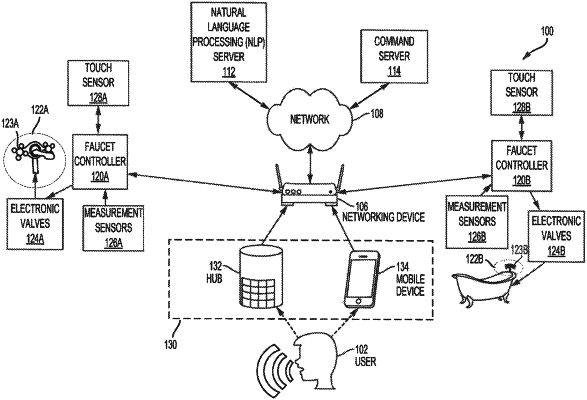| CPC E03C 1/057 (2013.01) [G05B 19/416 (2013.01); G10L 15/22 (2013.01); G10L 15/30 (2013.01); H04L 67/12 (2013.01); G05B 2219/45006 (2013.01); G10L 2015/223 (2013.01)] | 19 Claims |

|
1. A faucet system comprising
a user device;
a natural language processing (NLP) server;
a command server;
a faucet;
an electronic valve associated with the faucet; and
a faucet controller associated with the electronic valve,
wherein the user device is configured to
receive a voice command from a user; and
transmit information associated with the user device and audio data based on the voice command to the NLP server,
wherein the NLP server is configured to
receive the information associated with the user device and the audio data from the user device;
identify a user account associated with the user based on the information;
recognize speech from the audio data;
select a faucet service from a plurality of services associated with the user account based on determining that the speech is associated with a faucet function;
generate a speech-based command; and
transmit the speech-based command and data indicating the user account to the command server,
wherein the NLP server is remote to the faucet,
wherein the command server is configured to
receive the speech-based command and the data indicating the user account from the NLP server;
select a faucet from one or more faucets associated with the user account;
generate a faucet command specific to the faucet based on one or more properties of the faucet and the speech-based command; and
transmit the faucet command to the faucet controller,
wherein the faucet is able to be operated remotely, and
wherein the faucet controller is configured to
receive the faucet command from the command server; and
actuate the electronic valve upon receiving the faucet command,
wherein the faucet controller is further configured to
receive non-voice inputs from one or more elements associated with the faucet; and
transmit the non-voice inputs to the command server, and wherein the command server is configured to generate a subsequent faucet command,
wherein the command server and/or the faucet controller are configured to
override, complement, modify, halt, or adjust one command over the other in response to the speech-based faucet command and the non-voice inputs-based subsequent faucet command based on system settings and mode priorities.
|